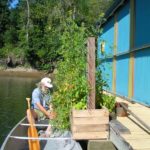I Finally Have My Own Community Garden Plot!
Last year I did some volunteer design work for the SE Portland Brooklyn Community Garden. I saw people working on their gardens, hanging out and eating together under an old plum tree. It looked like good clean fun to me and I was a little envious. These days I live on a floating home and have a tiny roof garden (courtesy of my hubs great design and building skills) and large bodacious tomato planters on the south side. I’d never considered a community garden before and now that I live on the edge of NW Portland I felt they would be too far into town to be practical.
Magic Happens!!!!
Jen and Stan Tonneson own and manage the Rocky Pointe Moorage, on the Willamette River (Multnomah Channel) where I live. They decided to build a private community garden for their tenants and also to romance new tenants for The Landing at Rocky Pointe. They built the beds, brought in soil, installed a hose bib and fenced it to keep critters out. I was the first person to sign up and my neighbors joined in. My dad and I were the gardeners when I was a kid and I have many happy memories of working with him in the garden. I have not had a veggie garden since although I have designed so many ….
Now I love my garden so much, it’s where I go first thing in the morning and on my way home in the evening, I stop and harvest dinner bits and greens for my morning protein smoothie. My time commitment has been quite reasonable. My hub, Bob, wondered when I signed up for my 4 x 8 bed if I’d enjoy caring for the veggies or if it would turn into an unmanageable chore. Summer is a very busy time for garden designers, ask the spouse of one and you will probably get an earful.
I teamed up with neighbors in late spring and used a seed catalog to plan what we would grow and share. We made plans to cover watering for each other during vacations. We also bought plants and got it going. I have focused on greens, a few different kinds of basil, one (and only one!) zucchini and lots of kale, oh… and two kinds of parsley.
Another neighbor, Betty, is trying all kinds of things… a grafted tomato called Indigo Ruby which is the best tomato I’ve eaten this year. She grew New Zealand spinach but didn’t like it so I’ve been gifted with lots and love it in a stir fry. The leaf is thicker than regular spinach, 26% protein, high in Vitamins A and C and it doesn’t bolt. I’ll grow just one plant in my box next year. I use the Swiss Chard and Kale the most as they are perfect in my morning protein smoothies and they are a wonderful way to get your calcium. I use them for kale chips – which are great with salt, olive oil, lime juice and cumin.
The Garden is a Joy in My Life
If you don’t feel you know how to start and care for an edibles garden, join a Portland community garden, here is the link to City of Portland. Commit now for next year so you can get a space from someone who is moving away. Get a pal to do it with and start small. Pick easy things to grow and buy your starts if you are looking for a very easy first year. I did both plants and seeds and the end result is I’m eating better than I have in years.
Diane one of my clients has been my inspiration. Her driveway edibles garden – which is what people in Portland sometimes do with a driveway – is simply awe inspiring. There are so many great local nurseries for starter vegetable plants, you can go just about anywhere to buy them. I got some unusual vegetable starts at New Seasons Market. I still like ordering seeds by mail: John Sheepers Kitchen Garden catalog and Territorial Seeds are two that I’ve used.








